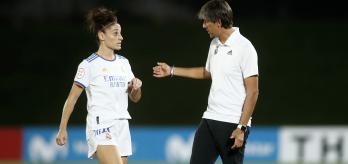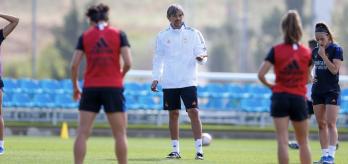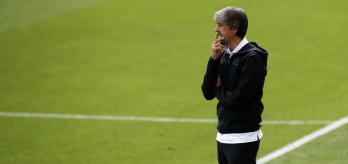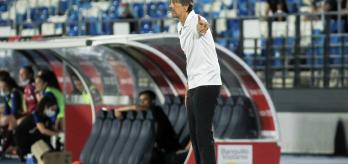In line with its Talent Development Programme, FIFA has undertaken a global ecosystem analysis. For many countries, talent development is key to achieving success, which is why FIFA is dedicated to giving every talent a chance. Here, FIFA’s Chief of Global Football Development Arsène Wenger and Technical Director Steven Martens provide some valuable insights into the various phases involved in talent development and the importance of receiving a holistic education.
Video interview
Read the interview transcript below.
Access to football and talent development
Steven Martens (SM): Arsène, we are here to talk about the various phases of talent development. The first phase is probably knowing who your talented youngsters are. How do you see that one? When do we start with it and what are we looking for?
Arsène Wenger (AW): I would say that before talent identification, there is even a prior step of giving people a chance to play. Then you can see who plays well and who doesn’t. But our immediate and first target is to give everybody a chance to play. Also, we are looking to develop world-class programmes in every single country. That’s our basic target.
SM: After conducting this global ecosystem analysis, our data shows that in the higher-performing countries, the real identification starts at around 11 and a half years old for the boys, and 12, 13 years old for the girls.
AW: That’s the time where you see if a body responds to the brain, because our feet have to do what our brain wants. At 11, 12 years of age, we know that. Here we see if the players are technically talented or not, meaning you have to welcome the ball. It is important to have a relationship with the ball as if it were your friend, controlling it and bringing it down to the ground, welcoming it into your home and having fun together.
SM: At some point, it starts to become fairly obvious who has a little bit more talent than the others. But it’s an ongoing process, meaning it doesn’t stop there at 12 years old, does it?
AW: It never stops. Technical work and technical ability can always be improved. It also improves by the number of touches on the ball we have in training sessions. One of the big problems we have in our sport is that we have a limited amount of time that we can dedicate to training, so we have to use it in the most efficient way. From 12 to 16, the focus changes from “me and the ball” to me, my team-mates and the ball, as well as introducing the aspect of opposition. This means we start to analyse the timing of your movement, the timing of your availability. When you give the ball, can you be available again? All these kinds of things show a player’s progression and understanding of a game. We, as coaches, have to equip the player with the tools that enable them to face any single situation in a game in the most efficient way. We have to prepare the players for that.
The role of academies
SM: During your time as a coach, you were always interested in the up-and-coming young players. You’ve always been a strong advocate of developing players through academies. What, for you, makes a good academy?
AW: A world-class development programme. That means absolutely having a long-term vision on what you can do and how to develop the player. I would say as well, a proper balance between competition and time dedicated to improve in training. We have seen by doing our report that in some countries, you have a deficit of competition and training. But always keep in mind that the development of a player is not linear. It can increase in speed during one period and decrease during another. That’s why we, as coaches, have to be open-minded. People can always surprise you. Not everyone develops at the same pace, and not everybody reaches their maximum at the same time. That’s why we have to find the key to help the player.
SM: That’s where I think the academy comes in again, because the coaches’ work inspires. If they work in an environment like an academy, they will inspire each other by working together, by having a general vision of the academy, correct?
AW: Exactly. And by stimulating each other as well. The organisations have to create an environment that encourages the player to develop, as well as create a culture of performance. That means having a clear picture of where I want to go and where I can go. The coach has a big part to play in that, but they have to create that picture, that clarity in where the player can be at the next level.
Good structures also help to develop human beings
AW: In addition to good pitches helping to create good players, I would say good structures also help to develop human beings. When I create an academy, I have to think, “How can I educate the man or woman inside the football player as well?” I believe that with the responsibility of football today in society, the quality of education, not only of the football player, is absolutely vital. Important aspects that you have to consider are making girls and boys accountable and respectful. We have to give them the love of the game, to place the game above their own ego. I have to serve the game. It’s not about only me, the love and respect I have for the game is absolutely vital. This is something which is decided before the age of 17.
The role of coaches
SM: From that perspective, I come to the coaches. Academies are of course important, but the coaches who work there are key. What makes a good coach for you?
AW: A good coach is somebody who has a clear concept of what they want and what they love in the game, is capable of expressing it in an understandable way, and is able to obtain it on the football pitch. They’re also someone who loves to help others. This means something more than just going out and coaching a session, they really try to understand who a player is and find the key to helping them. All players have different problems, and we have the capacity to help them solve them. That’s why this is a very interesting aspect of being a coach, we have the chance to be capable to influence people’s lives.
Coaches have the chance to influence people’s lives
SM: A coach can be somebody that makes a difference to the lives of people, not only in the way they play the game. From that perspective, you will often say that the top coaches are working at the top clubs with the top players, but maybe we also need fantastic coaches in the other stages of development?
AW: There are different ways of being a coach. When we speak about the top clubs and top teams, these are coaches who are able to use highly qualified technical staff in the most efficient way. It’s not the same job and it’s not the same ambition. I sometimes read interviews where they ask the player, “Who was the guy who influenced you the most?”, and we always expect the answer to be these coaches in Manchester or at Real Madrid. Instead, they say, “Oh, he’s a guy I met when I was 15 or 16, he is the guy who made me, gave me something that was very important.” This shows how important the coaches are at this level.
The role of training
SM: Let’s move on to training. In our study, we noticed that boys over the course of their playing development, between six and 23 years of age, get significantly more training sessions than girls. We also see a difference across the levels of play amongst the different federations. But the difference between boys and girls is especially big. We talk about training in terms of quantity, but there is also the quality aspect. Do you have any reflections on this?
AW: Ideally, we’d combine both. It is true that the girls are behind the boys on that front and we have to close the gap. Personally, I would say I think that will happen naturally, because the girls had a handicap, they started to play at the top level much later than the boys.
SM: And thus, fewer girls were being attracted to the game, but now it’s growing.
It is absolutely important that we correct that [gap in training opportunities between boys and girls]
AW: Exactly, we now see an explosion of girls’ football, and it’s absolutely fantastic. Every Women’s World Cup is a jump ahead. So they will make up this ground. But it’s still true that the quality of the competitions and training sessions, as well as the number of the training sessions, are behind and it is absolutely important that we correct that. I often say, “You can train to train, you can train to compete and you can train to win or to improve”. That means, whilst training, you need boys and girls to have a vision in their minds regarding what they will practice and how they can improve by doing that. The coach is responsible for this, to give them a clear vision of what they want to work on. And there’s only one solution: to educate coaches.
The role of playing and international competitions
SM: Now let’s turn to matches. In Europe, there are clearly more opportunities to play matches than in other confederations. But we see that, for instance, a 14-year-old boy from one of the top 20 countries in the world will play 44 matches per season, including friendlies. What do you think of that?
AW: I must say, personally I was surprised by the number of games he plays. Because if you think that you play for 40 weeks, 44 games for a young boy, you’re 14 years of age, the time dedicated to training is too short, since you go to school during the week and play games on Saturday and Sunday. We could do with 25 games and more training because what is very important is that the player doesn’t come up prematurely. I was always promoting young players, yet I got many players at 18 years of age who had huge flaws in their game. No left foot, no ability to head the ball, because they had no time to improve these aspects of their game. After this age, it gets very late to work on these elements, because from 18 onwards, you go into top-level competition and have even less time.
SM: So, let’s talk a little bit more about the national teams. We’ve got a U-17 World Cup with U-17 national teams and we’ve also got the U-20 equivalents. How important are both of these age brackets, and what is maybe different from the U-17 perspective to the U-20 perspective in terms of player development?
AW: The month you were born in and the number of competitions have a big impact. In Europe, you play every year, so all the players have a chance to play. That’s why maybe we have to increase the frequency of the U-17 World Cup, to give everybody a chance to play and gain experience.
SM: So, what you are advocating here is to say, “Let’s organise the World Cup maybe every year, so that in each confederation, teams play qualifiers on an annual basis, meaning national teams will be selected every year.” In our research, we discovered that if you are, for instance, unlucky enough to be 16 in the year when the U-17 World Cup takes place, as a boy you are five times less likely to be selected than if you were 17. So are national teams also important for the coaches, then?
AW: Of course, because you can compare. We live in a world of competition. Let’s not forget that competition means you only survive if you’re better than others. What we want always is to see where we stand. One of the big advantages of sport is that you can always see the result of the quality of your work. The competition gives you that.
Transition from junior to senior
SM: Players are in national teams, they are selected. At some point, they get to an age where they find themselves, in what I would call a twilight zone: the transition phase from junior to senior, between 18 and 23. It gets tougher during this phase and many get lost. What are your thoughts on this period?
AW: This is what we call the final pathway that you get through competition. It’s also the final mental hurdle, and that’s where we see the final part, I think, of the development of a player. It is a combination of motivation, stamina and being able to survive disappointment and analysing my own game. That’s where I slowly become an adult. Do I analyse well what’s happening to me? Can I resist disappointments? Can I bounce back from disappointments? I would say on top of this, to all these questions “we” as the football world don’t help players in this phase well enough.
It is a combination of motivation, stamina and being able to survive disappointment and analysing my own game
SM: As educators, coaches, academies and associations, we can all maybe do something to make sure there is good guidance. How do you see that?
AW: I see that as giving them progressive difficulties through competition. That means giving them a competition that is adjusted to their level and giving them a chance to improve. At the age of 17, a player has the tools required to be a football player, now it’s down to them. But to get further, you need to play.
SM: When you are a youth player in one of the top ten domestic leagues, you have a much smaller chance to play than if you were to play in the lower divisions.
AW: Exactly. That’s why today the clubs who educate football players – that in a few years will be the same for the girls – have to plan progressive difficulty through competition. Is he to play one year in a lower league? Or one or two years in another country in a top-level league, and then come back as a better player, closer to the elite level? In the past, we did it through training and competition, now it is mainly through competition.
SM: Because this is the phase where competition is further shaping you.
The importance of a holistic education
SM: Many players do not make it due to the sheer competition that exists. This leads us to think about the importance of solid education to prepare people for life. Let’s come back to that, because we’re now discussing the phase where not all players will make it to the next footballing level.
AW: Yes. I am convinced that it’s the modern responsibility of football. We have to help to build the character, but as well help to provide education. If I’m ten years old today, that means I retire in 2075. Can you tell me what kind of job you will do in 2050 or 2060? Nobody knows. But we can prepare people to adapt, and that’s why I believe that football has a huge responsibility today. I think some unions of football players are now conscious that they have absolutely to invest a lot of time and money in educating potential football players to deal with the challenges that arise if they are not successful.
SM: Yes and also taking care of their well-being because, well, we also shouldn’t underestimate the pressure that is on top athletes, whether they make it or not.
AW: If you look at the numbers of stressed players between 16 and 20, it’s nearly an appalling 50 per cent. It was the pressure; they invest all their time and energy into becoming a football player without knowing whether they will make it. The coaches are gradually becoming more conscious of the required mental guidance, involving psychologists, at clubs and academies. But of course, as you know, it happens more in Europe than anywhere else.
SM: Again, our research shows that certain academies do it, but also that there are quite a lot of academies, national teams and associations not doing it. So again, it’s a call for action to focus on that.
AW: I think it’s an important part of it.
Who's to benefit and final thoughts
SM: Okay. We are doing all this work to help associations and clubs. We all want more players to get a chance. But who, at the end of this long-term journey for both us and the global football community, is going to benefit from the programme?
AW: Basically, everybody. Especially regarding happiness in the world, we can contribute a little bit to making people happier, having a life where they enjoy playing, and for the best of them to have a big career. You can influence the world. I would also say that’s maybe the most exciting and the most inspiring thing. I played as a professional, but I played as well in my village. And I was happy in my village when I played football. Because we are with friends who can share something together. Also, let’s not forget that football has become so important that everyone in it has a political responsibility as well. They can influence the world.
SM: Any final thoughts or recommendations based on what we have done and what we are going to do?
AW: I would just say that we are here to help you. We love football, you love football, so let’s achieve something together that will make history. I would also say, as you said at the start, Steven, we want to give everybody in the world a chance to experience the joy of playing football at their appropriate level. It is an unforgettable experience and we want to help you to do that.
SM: Fantastic. Arsène, thank you very much for this interview.




















.variant64x64.png)


.variant348x164.png)

